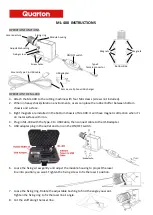
Doc. P/N 06-905
Rev. 1 / December 2018
PAGE / 11
8.0
IRM TESTING
8.1.
IRM Operational Overview
The Output Analyzer can be used to perform two important testing functions associated with the IRM firing circuit.
The first testing function assesses the IRM’s ability to supply the correct current (amps) required to activate the
actuator devices connected to the firing circuit; the second testing function assesses the integrity of the releasing
circuit field wiring by measuring the supervisory current at the IRM.
When the device is connected to an IRM for testing, the activation signal is provided via a release event on the fire
alarm control panel, such as when the release station is activated. The device will then measure the current supplied
by the firing circuit and display the result on the LCD panel. Four readings will be taken to ensure the Fire IRM is
supplying adequate firing current, with readings occurring momentarily (there is a slight delay between fire control
panel activation and firing circuit release).
IMPORTANT: The Output Analyzer ACTIVATE button does not apply to testing an IRM. Instead, activate using a
release event on the fire alarm control panel (e.g., activate the release station).
8.2.
Interpreting IRM Measured Results
Once you’ve used the Analyzer to test the activation current supplied by the IRM, the Analyzer will display the results
on the front panel as either IRM PASSES or FAIL REPLACE IRM. When the Analyzer is used to test the supervisory
current supplied by the releasing panel or module, it will display the supervisory current reading in milliamps. The
acceptable supervisory current reading at the IRM is 24mA +/- 4mA.
8.3.
IRM Testing Procedures
1.
WARNING!
Before you begin this test, disable the IRM and disconnect IVO(s) per the 06-552 IRM Manual.
2. Connect the Analyzer to the IRM as shown in 8.3-1 below.
Figure 8.3-1 IRM Circuit Activation Current Test
Select
Enter
Fire
(EPC Only)
Shunt






































